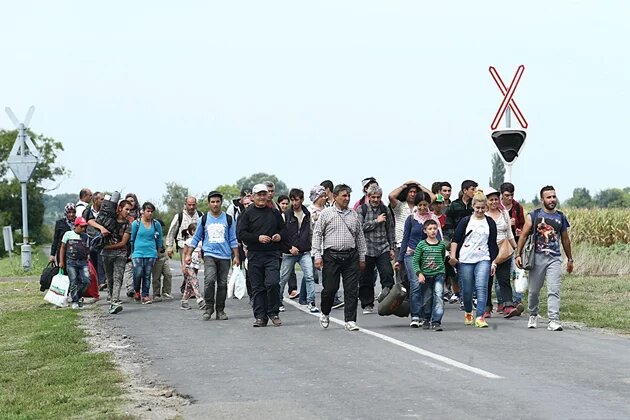
Recent Croatian history makes them well able to understand the plight of refugees from war torn areas and many of them have been welcoming. Others, however, fear the influx of different cultural and religious influences and the effects the migrants will have on the already difficult economic situation in Croatia.
For around six months - from September 2015 until the route’s closure in April 2016 - Croatia was part of the so-called Balkan route, along which almost a million migrants flowed from Greece via Macedonia and Serbia and on from Croatia into Slovenia, Austria and Germany. Croatia, one of the newer members of the EU, still carries the scars of the 1990s when the disintegration of Yugoslavia led to war and population displacement. This relatively recent history makes the Croatian people well able to understand the plight of refugees and the demands of post conflict peace building.
Refugee camps set up
As the waves of migrants began, the Croatian government set up a first refugee camp for 5,000 people near the border with Serbia. This was followed by a second camp for 15,000 persons, near the border with Bosnia. All the refugees were housed in military tents and processed here but registration details were not shared with other Member States in order to avoid later returns as stipulated by the Dublin Regulation. (This said that migrants were the responsibility of the country into which they had first entered the EU).
Basic aid like food, blankets, and medical care was provided by the government, as were the logistics of registration, reception and transit but there were also numerous volunteers working in the camps to provide aid, comfort and information about the procedures for entering and leaving Croatia. One of the main state undertakings during the height of the migrant flow was to provide transit facilities to the Hungarian and Slovenian borders but this came to an end with the abrupt closure of frontiers in March 2016. Humanitarian aid was offered in camps in Opatovac and Slavonski Brod mainly by volunteers from civil society organizations. Although there was a lack of political consensus in Croatia as to how to deal with the migrants, Croatian activists founded an initiative known as Welcome to assist them.
Genuine asylum seeker or irregular migrant?
The Slavonski Brod camp became a place of forcible detention for many refugees. After the closure of the camp, refugees who left either claimed asylum and were transferred to asylum seekers’ reception centers in Zagreb and Kutina, or maintained the status of ‘irregular migrants’ and were transferred to a foreigners’ detention centre in Ježevo. Those, who had written confirmation that their return had been postponed, were accommodated in alternative detention centres. Returns of migrants to their previous country went on between mid November 2015 and March 2016. The process began with the Slovenian police segregating all non-Syrian, Afghan and Iraqi refugees for return and was soon adopted by all the police of the countries along the Balkan route. The extreme tension caused by the closure of the Macedonian border meant that thousands of migrants massed on the Greek side found themselves in makeshift camps in squalid and insanitary conditions. This unhappy state of affairs meant that genuine asylum seekers were caught together with economic migrants in often inhuman conditions.
Although not a member of the Schengen area, Croatia is following the EU decision that migrants can only enter the EU Schengen area if they meet the official requirements of the zone ie wish to claim asylum or have been chosen on a case by case basis on humanitarian grounds. This has meant that migrant transit through Croatia has been brought to a halt. Like the Visegrad countries (Hungary, Poland, Czech Republic, Slovakia) Croatia has also introduced amendments to its Foreigners Act that criminalize any effort by its citizens to assist a foreigner illicitly entering, transiting or residing in the country. This change in legislation has been criticized as ‘the criminalization of solidarity ‘.
Sharing the migrant burden
Public debate on hosting and accommodating 1,617 refugees by the end of 2017 as agreed at the EU Council has been twofold. While on the one hand, the Croatian public has been welcoming and open to providing assistance to refugees from Syria and other war affected countries (their own war and refugee experience being a major factor), some are more wary and prefer to keep their distance, fearing to face future reality. This fear primarily reflects fear of the different cultural and religious influences of the new comers as well as economic concerns as Croatians see the newcomers taking scarce employment opportunities in an already difficult market. The lack of any effective government communication policy has only made the public more fearful and done little to prepare Croatian society for such rapid and visible change.
Croatia is, however, willing to participate in the EU’s proposal to relocate and resettle refugees according to an agreed quota system. There is a plan to relocate and resettle 50 people from Italy, Greece and Turkey (one for one rule) in June and July and then 84 refugees every month until 2017 but the government does not appear to have either the operational capacity or resources to do it successfully. There are so far only poorly conceived integration programmes to accommodate the 170 people, who have obtained international protection status. The awarding of this, and the subsidiary protection status, allows access to employment, education, health and social care but the process of determining who qualifies for such a status can be time consuming.
This article is part of our dossier "Crossing borders – refugee and asylum policy in Europe".